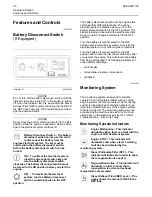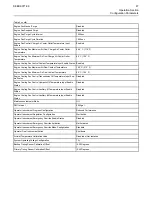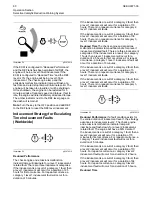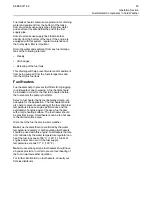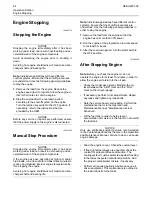
Note:
If the engine has not been run for several
weeks, fuel may have drained. Air may have moved
into the filter housing. Also, when fuel filters have
been changed, some air will be left in the filter
housing. Refer to the Operation and Maintenance
Manual, “Fuel System - Prime” (Maintenance
Section) for more information on priming the fuel
system.
Ether Injection System (If
Equipped)
The ether injection system is controlled by the ECM.
The ECM monitors the coolant temperature, intake
air temperature, ambient air temperature, and
barometric pressure to determine when ether
injection is needed. At sea level, ether will be used if
any of the temperatures fails to exceed 0° C (32° F).
This temperature is subject to an increase as
barometric pressure increases.
Personal injury or property damage can result
from alcohol or starting fluids.
Alcohol or starting fluids are highly flammable
and toxic and if improperly stored could result in
injury or property damage.
i06092648
Follow
the
procedure
in
this
Operation
and
Maintenance
Manual,
“Starting
the
Engine”.
Starting
the
Engine
Engine exhaust contains products of combustion
which may be harmful to your health. Always
start and operate the engine in a well ventilated
area and, if in an enclosed area, vent the exhaust
to the outside.
Starting the Engine
Refer to the Owners Manual of the OEM for your type
of controls. Use the following procedure to start the
engine.
1.
Place the transmission in NEUTRAL. Disengage
the flywheel clutch in order to allow the engine to
start faster, and to reduce the draining of the
battery.
2.
Turn the ignition switch to the ON position.
During the key on, all warning lamps will illuminate
for a few seconds, in order to test the circuits. If
any lamps do not illuminate, check the bulbs and
replace as necessary.
NOTICE
Do not engage the starting motor when flywheel is
turning. Do not start the engine under load.
If the engine fails to start within 30 seconds, release
the starter switch or button and wait two minutes to
allow the starting motor to cool before attempting to
start the engine again.
3.
Push the start button or turn the ignition switch to
the START position in order to crank the engine.
Do not push down or hold the throttle down while
the engine is cranked. The system will
automatically provide the correct amount of fuel
that is needed to start the engine.
4.
If the engine fails to start within 30 seconds,
release the start button, or the ignition switch. Wait
for 2 minutes in order to allow the starting motor to
cool before attempting to start the engine again.
NOTICE
Oil pressure should rise within 15 seconds after the
engine starts. Do not increase engine rpm until the oil
pressure gauge indicates normal. If oil pressure is
not indicated on the gauge within 15 seconds, DO
NOT operate the engine. STOP the engine, investi-
gate and correct the cause.
5.
Allow the engine to idle for approximately 3
minutes. Idle the engine until the water
temperature gauge has begun to rise. Check all
gauges during the warm-up period.
Note:
Oil pressures and fuel pressures should be in
the normal range on the instrument panel. Engines
that are equipped with
“
WARNING
”
lamps do not
have an operating range. The
“
WARNING and
DIAGNOSTIC
”
lamp (if equipped) will flash while the
engine is cranking. The lamp should turn off after
proper engine oil pressure or fuel pressure is
achieved. Do not apply a load to the engine or
increase engine rpm until the oil pressure gauge
indicates at least normal pressure. Inspect the engine
for leaks and/or unusual noises.
SEBU9071-06
49
Содержание 2206F-E13TA
Страница 126: ......
Страница 128: ...SEBU9071 2020 Perkins Engines Company Limited All Rights Reserved 128 December 2020 ...


